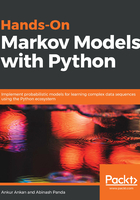
Markov processes
A stochastic process is called a Markov process if the state of the random variable at the next instance of time depends only on the outcome of the random variable at the current time. In simplistic mathematical terms, for a stochastic process, S = {R1, R2, . . ., Rn} = {R}t=1, . . ., n, to be a Markov process, it must satisfy the following condition:

According to the previous condition, the probability distribution for any variable at any given instance in a Markov process is a conditional distribution, which is conditioned only on the random variable at the last time instance. This property of a system, such that the future states of the system depend only on the current state of the system, is also known as the Markov property. Systems satisfying the Markov property are also known as memoryless systems since they don't need to remember the previous states to compute the distribution of the next state, or, in other words, the next state depends only on the current state of the system.
A very common example used to explain the Markov process is a drunk man walking along a street. We consider that, since the man is drunk, he can either take a step backward, a step forward, or stay in his current position, which is given by some distribution of these, let's say [0.4, 0.4, 0.2]. Now, given the position of the man at any given instance in time, his position at the next instance depends only on his current position and the parameters of the system (his step size and the probability distribution of possible actions). Therefore, this is an example of a Markov process.
In the previous example, let's assume that the drunk man takes an action (steps forward/backward or stays in his position) at fixed intervals of time and his step size is always the same. With these considerations, the Markov process in our example has a discrete state space. Also, since the man takes steps after fixed intervals of time, we can think of it as a discrete time. But Markov processes don't need to have discrete state space or discrete time intervals. Considering discrete and continuous time as well as discrete and continuous state space, we can categorize Markov processes into four main categories:
- Discrete time and discrete state space
- Discrete time and continuous state space
- Continuous time and discrete state space
- Continuous time and continuous state space
We will discuss each of these categories of Markov process in more detail in the following sections.